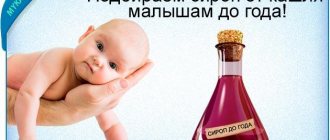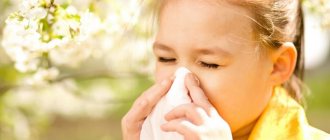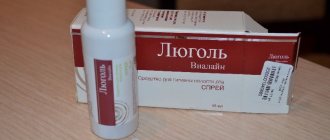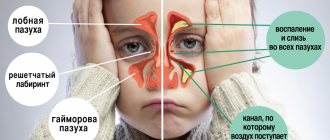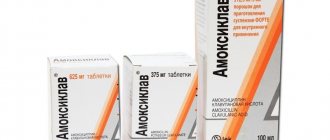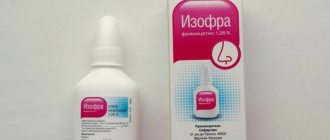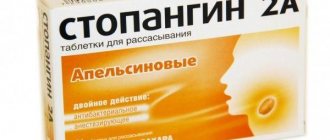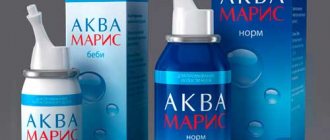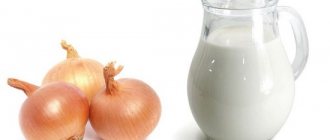Inflammatory processes of the upper respiratory tract are often accompanied by attacks of dry cough. In order to relieve this syndrome, the use of antitussive drugs is justified, which can significantly alleviate the child’s condition and suppress paroxysmal forced exhalations.
The pharmacological market is represented by a wide variety of dosage forms of drugs for non-productive cough attacks. Cough sprays for children are the most effective means of acting directly on the inflammatory focus.
Which spray to choose or a list of cough sprays
Cough aerosols are very effective for pharyngitis - an inflammatory process in the pharynx. The disease is caused by microorganisms - bacteria, viruses, fungi. During their life, the mucous membrane becomes inflamed, pain, soreness, and a dry barking cough appear. With inadequate treatment, the process spreads from top to bottom, subsequently the trachea, bronchi, and lungs may be affected. Aerosols can be used together with antibiotics, antivirals, and antipyretics.
All sprays have local activity and are practically not absorbed into the blood. When sprayed onto the mucous membrane of the larynx, the medicine covers it with a thin layer. The disadvantage of all sprays is that the active substance is quickly washed off with saliva and swallowed, so it is recommended to use medications several times a day, always after meals, without taking liquid for an hour after treating the throat.
The aerosol is suitable for the treatment of acute and chronic pharyngitis, inflammatory diseases of the oral cavity.
Hexoral is used twice a day, 1 throat irrigation for 1-2 seconds. When spraying, you must hold your breath.
Side effects of the drug:
- allergic reactions - urticaria, laryngeal edema;
- cough if the product gets into the lungs;
- dryness, local inflammatory reactions in the mouth.
Strepsils Plus
The aerosol consists of two antiseptics - dichlorobenzyl alcohol and amylmethacreazole, as well as a local anesthetic - lidocaine. The combination of antiseptics provides broad antimicrobial activity, and lidocaine effectively anesthetizes the throat mucosa. Auxiliary essential oils of mint and anise help relieve inflammation and eliminate cough.
Adults need to use the product 3-4 times a day, making two injections.
The best pharmacy products
Inhalipt is an antiseptic spray based on streptocide. Additional components – eucalyptus ether, peppermint oil, thymol. Inhalipt is prescribed to patients with throat diseases of a cold, infectious, or viral nature. This aerosol demonstrates antimicrobial, anti-inflammatory, and cooling effects. Inhalipt is approved for use in children over 3 years of age and in adult patients.
An effective anti-inflammatory agent for cold coughs
Tantum Verde is an Italian remedy for the treatment of ENT diseases. The active components of the aerosol anesthetize, stop the local inflammatory process, and demonstrate a local anesthetic effect. The main active ingredient of the spray is benzydiamine; the auxiliary component is menthol flavoring, which gives the medicine a minty smell and taste.
The use of Tantum Verde aerosol allows you to solve the following medical problems:
- reduce the frequency and intensity of coughing attacks;
- remove redness on the mucous membrane of the throat;
- stop the inflammatory process;
- relieve swelling.
Shunam is a natural aerosol made from aromatic oils and herbal extracts. The action of the drug is aimed at activating the process of coughing up mucus and combating pathogenic microorganisms (causative agents of inflammation). Shunam is indicated for dry, wet cough in a child or adult patient. The medicine is also administered in the general course of treatment of bronchial asthma.
Italian anti-cough aerosol of combined action
Algoven is another natural spray with the addition of ginger, sage, and honey. This is one of the best remedies for dry cough. The use of this aerosol allows you to eliminate the feeling of burning, sore throat, moisturize the mucous membrane, and stop coughing attacks. Algoven relieves pain, has astringent, soothing properties, helps to cope with local discomfort in the throat, which accompanies the course of many respiratory diseases.
Hexoral is a spray based on hexethidine. Demonstrates an antifungal effect, helps to quickly relieve inflammation and get rid of dry cough. Use the aerosol twice a day for a week.
Bioparox is an antibacterial spray, most often prescribed to patients with purulent tonsillitis. It has a local anesthetic, anti-inflammatory effect, moisturizes, and protects the mucous membrane. It is not suitable for combating dry cough and accompanying redness and sore throat.
Aerosol "Ambulance" is a natural local preparation based on propolis. Can be used to combat allergic and cold coughs. This composition relieves pain and relieves inflammation. The spray can be sprayed onto the mucous membrane in order to quickly heal wounds and other microdamages; the medicine helps to cope with the consequences of insect bites.
Faringosept is an effective aerosol for dry cough, eliminates pain, softens, moisturizes the “affected” mucosa, dilutes sputum, and promotes its unhindered elimination.
The spray demonstrates an anti-inflammatory and anesthetic effect. Use this drug up to 4 times a day for 2 weeks (spray the aerosol directly onto the inflamed areas of the throat mucosa).
Cough spray for children and pregnancy
The use of aerosols for children under one year of age is strictly prohibited , as this can cause bronchospasm and respiratory arrest.
Cough sprays for children can be used from the period when the child learns to independently hold his breath while irrigating his throat, this is possible already at the age of 2-3 years. Video: Miramistin - what kind of spray is this?
List of cough sprays for children:
- Hexoral;
- Strepsils from 12 years old;
- Tantum Forte;
- Miramistin;
- Alvogen.
For coughs during pregnancy and breastfeeding, you can use Hexoral, Alvogen and Tantum Verde. Women during lactation should spray their throats only after feeding the baby.
During treatment with inhaled drugs, one should not forget that they have side effects and contraindications that must be taken into account. Therefore, sprays must be used with caution, and if any unwanted reactions develop, consult a doctor immediately.
source
Contraindications, side effects and consequences of overdose
Cough sprays often have contraindications such as:
- The period of carrying the baby and breastfeeding.
- Increased susceptibility to allergic reactions.
- Early childhood (up to 2-3 years).
Side effects of aerosols in children or adults can manifest themselves in the form of soreness and burning in the mouth, which gradually disappear on their own . If severe reactions occur in the form of skin rashes or itching, you will need to stop using the drug and consult a doctor.
If the dosages specified in the instructions for use are not observed, there is a risk of developing negative phenomena - deviations from the gastrointestinal tract, convulsions, tremors of the limbs, cardiovascular problems.
Source: pulmono.ru
At what age can children be treated with the spray?
High-quality topical preparations eliminate several symptoms of respiratory tract diseases, facilitate treatment and speed up recovery. If your immunity is good, then local antiseptics and painkillers are often sufficient.
The spray differs from syrups and drops in the method of delivering the medicine, the size of the particles, the depth of penetration, and the age from which use is permitted. Aerosol is a special dosage form. It is characterized by mixing a liquid or solid with a gas.
What is a spray
The bottle is equipped with a small mechanical pump (in a glass container it can be seen through the wall). The pressure inside and outside is equal to atmospheric pressure. Activate the pump by pressing the nozzle with your finger. The bottle can be plastic or glass, which reduces the cost of production of the drug.
Oral spray droplets (for injection into the mouth and throat) are quite large (more than 5 microns) and settle only in the upper part of the respiratory tract. Meanwhile, a cough can appear when receptors located in the mucous membrane of the entire respiratory tract, including the trachea and bronchi, are irritated.
Recommendations for parents on using the spray:
- Do not use drugs with the same active ingredients at the same time, even if they have different names.
- First give your child warm, clean water to rinse his mouth and throat.
- Use only medications prescribed by your doctor.
- Use antibiotic spray for at least 5 days.
Parents should themselves inject the medicine into the baby’s throat as many times as indicated in the instructions. The spray can be used to treat the oral cavity and tonsils of a child who does not yet know how to rinse his mouth. Some children get used to this procedure from the age of 2, while others master the technique only by the age of 4–5. An older child can use the spray independently after instructions from an adult.
Cough spray
First you need to recognize what kind of cough your child has. The list of characteristics includes more than 10 signs: dry, wet, barking, allergic... A cough does not always need to be treated. Even in healthy children, the reflex is triggered up to 6 times a day. The main sign of a cough not associated with illness is short duration and episodic occurrence.
In the morning, with the help of a reflex exhalation through the mouth, the child gets rid of the mucus accumulated in the bronchi. Babies cough when they choke on food. When the secretion of saliva increases during teething, the protective reflex is also triggered. In such cases, there is no need to use medications.
Features and advantages of a spray for relieving coughs arising from diseases of the upper respiratory tract:
- The medicine settles only on the tonsils and walls of the pharynx.
- Possibility of independent use by a school-age child.
- The therapeutic effect occurs almost as quickly as with intramuscular injections.
- By increasing the surface of contact of the drug with the mucosa, smaller doses of the drug can be used.
- Simplicity and ease of use.
A spray for topical use treats adenoiditis, pharyngitis, sore throat, laryngitis, and allergic diseases in children over 1–2 years of age. If a small child is afraid of injecting medicine into the oral cavity, then moisten a sterile bandage with the liquid from the can and wipe the inside of the cheeks. For the treatment of bronchial asthma and obstructive pulmonary disease, aerosols are preferable.
Pharmacodynamics
Sprays are inhalation drugs that have a local effect on the site of inflammation.
Pharmacodynamics implies the rapid elimination of infectious and inflammatory diseases of the upper respiratory tract. The active component Fusafungin is the basis of many antibiotic-based products. It has a pronounced bacteriostatic effect against many dangerous microorganisms. The product has an anti-inflammatory effect. The mechanism of action of the drug is based on its ability to integrate into the cell membrane of a pathogenic microorganism. Due to this, irreversible changes occur in its structure and the disease recedes.
Active action on the source of inflammation leads to a decrease in the severity of symptoms after the first use. In many cases, the severe clinical picture disappears 2 days after starting treatment.
Mechanism of action of cough aerosols
The can is made of metal alloys that can withstand pressure inside the container equal to several atmospheres. This is one of the reasons why aerosols are usually more expensive than sprays. In addition to the medicine, it contains a gaseous propellant that “pushes out” droplets of the therapeutic substance measuring 2–5 microns.
The “fog” penetrates deep into the respiratory tract, reaching the trachea and bronchi. During one application, press the spray head of the aerosol can 1-2 times. As a result, the required amount of the active substance reaches the mucous membrane of the respiratory tract.
When spraying the medicine in the throat area, you need to hold your breath. Ingestion of foreign substances can cause bronchospasm in a small child. Therefore, aerosols most often have an age limit of 5–6 years. Depending on the medicinal substance, the “qualification” increases to 8–18 years.
Cough aerosols contain cromoglycic acid, sodium cromoglycate, salbutamol or beclomethasone (a glucocorticoid, a hormonal substance). The properties of such compounds are anti-allergic, anti-inflammatory and anti-asthmatic.
The mechanism of action is to stabilize the membranes of mast cells involved in the development of an allergic reaction. As a result, the release of inflammatory mediators, such as histamine, into the blood is blocked.
Benefits and Precautions
A fine aerosol is a dosage form in which the active substance can penetrate as deeply as possible into the respiratory tract. Therefore, for bronchitis, the use of drugs in this form is widely practiced.
Of the drugs for the treatment of various manifestations of bronchitis, only bronchodilators are produced in ready-to-use aerosol can form. A pocket inhaler is convenient because it is always at hand and allows you to quickly relieve bronchospasm. Another advantage is the presence of a dispenser. It is possible to use the antibacterial drug Bioparox in the form of a dosed aerosol for the treatment of bronchitis.
All other drugs for inhalation treatment of bronchitis, cough relief, fighting infection and inflammation are produced in the form of solutions for nebulizers. These are special devices that allow you to create an aerosol with small particle sizes from a solution.
When treating respiratory obstruction and cough with aerosol preparations, one must remember the high risk of an allergic reaction to medications. Therefore, any aerosol can be used only as prescribed by a doctor and in the absence of hypersensitivity to its components. It is necessary to strictly follow the instructions for use of the metered-dose aerosol or inhalation solution.
source
Causes
The most common provocateurs of cough in children are:
- viruses;
- bacteria;
- allergens;
- poor quality air.
The most common causes of cough in children are infectious diseases and allergies (about 92% of all cases). Of this number, approximately 90% are due to infections, and only 10% are due to an allergic reaction. The champion among infectious diseases that provoke cough is ARVI.
A chest cough is never the only symptom of the disease. And just by the nature of a child’s cough, it is very difficult to determine what exactly triggered it: an infectious disease, an allergy, or dry, stale air in the apartment. This should be determined by an experienced physician, who in such situations analyzes a number of factors and symptoms, and not just the cough.
In addition to allergies or infections, cough can also be triggered by external factors, for example, bad indoor air. Sometimes, in order for the baby to start coughing, it is enough to simply not ventilate the children's room for several days and place a heating device near the child's crib. Dry air causes the lungs to produce additional mucus, which the body will reflexively try to get rid of by coughing.
Coughing in children is more dangerous than in adults. This is explained by the fact that in children under 3-5 years of age, the respiratory muscles are still poorly developed, so it is much more difficult for them to cough up phlegm than for adults.
If a child cannot cough up all the mucus accumulated in the lungs, then viruses will settle there. In this case, a common cold can turn into prolonged bronchitis or pneumonia. How to treat bronchitis and cough in an adult is described in this material.
Prevention
In order to prevent the development of relapses of dry paroxysmal cough in adults in the future, it is necessary:
- Protect yourself from colds;
- take prescribed medications regularly;
- do not drink too cold drinks;
- constantly ventilate the room;
- spend more time in nature;
- take walks;
- do morning exercises every day;
- apply the principles of hardening;
- eat a balanced diet;
- do fluorography on time;
- get vaccinated against flu;
- dress according to the weather, etc.
These measures will help protect against hypothermia and the development of bronchopulmonary diseases. Thus, a dry paroxysmal cough can be a symptom of a variety of pathologies, although the general symptoms are similar. But it is accompanied by a variety of manifestations of the body, corresponding to the disease that caused it. Therefore, treatment can only be strictly targeted.
source
Types of chest cough
This symptom can be productive (wet) or nonproductive (dry). A nonproductive cough usually appears at the beginning of the inflammatory process. Then, with proper treatment, sputum forms, which the child must cough up.
A dry cough can be paroxysmal. It exhausts the child and does not bring relief; it is also called “barking.” This cough can occur with the following diseases and conditions of the body:
- acute bronchitis;
- initial stage of pneumonia;
- the presence of a foreign body in the respiratory tract.
Wet is accompanied by sufficient sputum production, which alleviates the patient’s condition. The best children's cough medicines are collected here.
pharmachologic effect
Alvogen spray is an auxiliary remedy for eliminating inflammatory processes in the throat or larynx. The drug eliminates cough, accelerating the recovery of patients with bronchial diseases.
The effectiveness of the spray is due to the characteristics of its pharmacological action:
- reduction of the inflammatory process;
- immunomodulation. Ginger root strengthens the body's defenses by saturating the body with vitamins, minerals and bioactive substances;
- eliminating cough. When sprayed, the spray creates a microfilm on the pathological area, which moisturizes the mucous membrane and reduces swelling. Secondary irritation of receptors by dust particles or microorganisms is prevented;
- destruction of bacteria. Essential oils and acacia honey provide a local antiseptic effect;
- anesthesia. The effect is moderate.
Types of cough medications
Today, pharmacies sell a huge number of products designed to combat children's cough. All of them are diverse in their composition, origin, main action, and price.
Cough medicine will help a child only when it is chosen correctly. With all the wealth of drugs, you cannot use them without a doctor’s prescription. This also applies to plant-based syrups.
Children's cough medicines can be divided into three large groups. They are used depending on the cause and type of cough. Some drugs are anti-inflammatory in nature, others reduce the viscosity of sputum, and others promote its rapid clearance. The composition of the preparations can be of herbal (Breast collection, for example), synthetic or combined origin.
Antitussives
They are taken for a dry, debilitating, painful cough, when the child’s sleep is disturbed, his appetite disappears, and his general condition worsens. Most often, such a cough is a symptom of whooping cough or pleurisy. The main task of antitussive drugs is to suppress the cough reflex.
Most antitussives are not prescribed to children under 2–3 years of age. Do not take antitussives and expectorants at the same time. The child will have mucus accumulate in the lungs and bronchi, which he will not be able to cough up. Stagnation of mucus leads to pneumonia and secondary bacterial infections.
Expectorants
These drugs are prescribed when the sputum is well separated when a child coughs. Expectorant medications help to quickly clear excess mucus from the respiratory tract.
Mucolytics
These cough medications help thin mucus without increasing its volume. Mucolytic drugs usually include active ingredients such as:
- acetylcysteine (“Fluimucil”, “ACC”, “Vicks Active Expectomed”);
- ambroxol (“Lazolvan”, “Ambrosan”, “Halixol”, “Ambrobene”);
- bromhexine (“Bronchosan”, “Solvin”, “Bromhexine”).
As a rule, mucolytics are prescribed for:
- pneumonia;
- bronchitis;
- laryngitis;
- tracheobronchitis;
- bronchial asthma.
Ointments for colds
Sometimes, for colds with cough, ointment is used as a good antiseptic, which has irritating and warming properties. Usually they use Doctor MOM ointment or Doctor Theiss Eucalyptus cold balm. They relieve cough and runny nose. Age restrictions: up to 2 years.
There is also a cough ointment for children under one year old “Pulmex Baby”. Can be used for babies from six months of age. It contains essential oils of tropical plants. The ointment is applied once a day.
Warming cough ointments for children are applied with rubbing movements on the back between the shoulder blades and chest, as well as on the feet.
Do not apply ointment to the heart and face areas. It is forbidden to use the ointment at elevated temperatures or skin lesions. It is better to rub the ointment in at night, after which the child should be dressed in warm pajamas and put to bed.
How to treat a cough with lozenges
Cough lozenges soften and ease breathing, reduce sore throats, and relieve sore throat. They contain menthol, eucalyptus extract, mint, and anise. The most popular lollipops are:
Allowed for children from 5 years old. Give one lozenge every 3 hours. As an alternative option, herbal cough lozenges “Doctor MOM” with menthol, ginger, and licorice are suitable. Allowed for children from 2 years old.
Cough lozenges
Cough lozenges are applied to the coughing child’s chest and back in the form of compresses. Used in several variations:
- with vinegar, vodka and mustard (cannot be used for children);
- honey and salt (soak gauze in the mixture, apply to the chest, cover with plastic on top, tie with a scarf).
- a mixture of honey, flour and vegetable oil in equal proportions.
Dry medicine
Dry cough medicine is a combination drug with anti-inflammatory and expectorant effects. Liquefies and removes mucus from the respiratory tract. The main component is marshmallow root. The drug is sold in powder form from which a suspension is prepared. Can be used from 2 years of age.
Sprays
The spray can only be used when the child can already control his breathing. If you spray the product directly into the throat, your baby may experience a spasm. Most cough sprays can be used for children aged 3 years and older. Most often they are prescribed for diseases of the upper respiratory tract, irritated throat and dry, hysterical cough. Sprays well moisturize the mucous membrane, relieve swelling, relieve pain and stop inflammatory processes.
Sprays do not treat bronchitis and pneumonia.
The most famous trade names:
Acceptable cough medications for infants under 1 year of age if there is fever and chest pain
Among mucolytics, children under one year of age are allowed:
- "Ambroxol";
- "Lazolvan";
- "Ambrobene";
- "Bronchicum";
- “Fluimucil (contains acetylcysteine);
- “Bromhexine (syrup).
Among expectorants, children under one year of age are allowed:
- "Gedelix". Herbal preparation. For persistent dry cough, Gedelix syrup can be given from birth. The daily norm is half a teaspoon per day. For infants, you can dilute it in a bottle with water or juice. Drinking plenty of fluids is recommended.
- "Liquorice root". This syrup is prescribed to children under 2 years of age.
- Dry cough medicine for children. The drug is approved for use from 6 months. It is necessary to dilute the powder (1 packet) in 20 ml of boiled water. Give the resulting mixture 15 drops after meals 4 times a day.
- Linkas. The medicine reduces cough, promotes thinning and better discharge of sputum, and relieves sore throat. Allowed for use from 6 months. You should give your baby half a teaspoon a day for a week or 10 days.
- "Stoptussin." These drops are used for dry cough, starting from six months. A single dose depends on the child’s weight: if the child weighs less than 7 kg, dilute 8 drops; with a weight of 7 - 12 kg - 9 drops per 100 g of water, tea, fruit juice. The medicine should be given to the child 3-4 times a day. The dose of liquid for diluting drops cannot be reduced.
Cough medicines for children from 1 to 2 years old
Treatment of wet cough in children aged 2 to 6 years is carried out with the drugs listed above, as well as with:
For children from 2 to 3 years old
If a child’s cough occurs against the background of an acute respiratory viral infection, then treatment can begin with expectorants of plant origin based on decoctions of herbs such as:
- wild rosemary;
- coltsfoot;
- elecampane;
- plantain juice;
- black radish with honey;
- thyme;
- anise.
These drugs are approved for children who are not allergic to various injuries and plants. The drugs “Prospan” and “Gedelix” are good for cough.
In children with allergies, these drugs can cause swelling of the larynx and laryngospasm, allergies in the form of urticaria and other complications.
The main active ingredients of these products are saponins and plant alkaloids, which make bronchial mucus more liquid, increase the amount of mucus, increase bronchial contraction and facilitate easier expectoration of sputum.
When treating dry cough over the age of 2 years, in addition to the above drugs, the following are also used:
- "Sinekod" syrup"
- "Alex Plus";
- "Tussin Plus";
- "Bronholitin";
- "Codelac";
- "Codterpin";
- "Libexin";
- "Terpincode";
- thermopsis grass.
Cough preparations for children aged 3 years and older
The following medications are allowed to treat:
- "Bronchocin";
- "Bronholitin";
- "Codipront" (contains codeine);
- "Ambroxol";
- "ACC" ("Acetylcysteine"; "Mukobene"; "Fluimucin").
pharmachologic effect
The nature of the influence of Cashnol on the human body is determined by its chemical composition. The versatility of the effects achieved is achieved through the complex effects of synthetic substances.
Salbutamol belongs to the group of bronchodilators. The drug affects the smooth muscles of the respiratory tract through activation of beta-adrenergic receptors. There is an expansion of the lumen of the bronchi with an improvement in air passage.
Fact! The wide range of properties of Kashnol for cough determines the effectiveness and demand of the medicine. Menthol in the composition of the medication additionally soothes the mucous membrane of the trachea and larynx irritated by provoking factors.
Bromhexine hydrochloride is an expectorant that enhances the production of liquid mucus by stimulating goblet cells. Additionally, the speed of movement of the cilia of the inner lining of the bronchi increases. The result is the synthesis of liquid sputum with acceleration of its removal from the respiratory tract. Clinically, this will be accompanied by an increase in wet cough with increased expectoration.
DOWNLOAD - instructions for using Cashnol syrup
Guaifenesin is a mucolytic that directly affects the structure of mucus. By destroying the bonds between mucus molecules, it is possible to increase the elasticity of the secretion, which becomes liquid. The result is easier coughing.
Note to parents: tips for choosing
When choosing cough medications, you must first of all focus on the prescription received from your doctor. It is important to take into account some recommendations and tips:
- Treatment of chest cough should begin with drinking plenty of fluids, and not with medications, inhalations, or herbal infusions.
- Antitussive and expectorant or mucolytic drugs should not be used simultaneously.
- Antibiotics and drugs to dilate the bronchi should not be used without a doctor’s prescription.
- Herbal medicines should be treated with the same caution as medications. They should not be overdosed.
- If a child has diabetes mellitus, syrups should be used with caution.
- In case of allergic reactions, the drug should be discontinued immediately.
- In case of congenital pathologies in a child, some drugs are strictly contraindicated. You need to read the instructions carefully.
- When taking mucolytics, side effects may occur: an allergic reaction and bronchospasms.
- If therapy is ineffective within 3-4 days, you must consult a doctor again.
Adenoids in children: all available treatment methods
Treatment of sore throat at home with folk remedies and medications is described in this article.
conclusions
What should I give my child for a chest cough? Only the drug prescribed by the doctor, and not recommended by the pharmacist at the pharmacy. You need to start treatment with simple but effective measures:
- maintain moist, fresh air;
- give plenty of warm drinks.
Remember: No medicine will help if these simple conditions are not met. The treatment of wet cough in a child is described in detail here.
source
List of sprays for dry cough and sore throat for children and adults
Cough spray is exactly the type of medication that will help quickly and effectively relieve a sore throat. But since the cough reflex is a symptom not only of infectious and colds, many questions arise.
This applies to allergic conditions, sinusitis and other diseases in which the provocateur is not an infection. How effective is the aerosol in such cases?
Let’s add to the existing questions the moment of selecting a product. The pharmacy will offer you an expensive one, but how effective is it in reality? There are more questions. And you can find the answers only after you have studied the instructions for use. Customer reviews will complete the picture.
Overdose
In case of an overdose of Bioparox, symptoms such as numbness of the oral cavity, problems with blood circulation, burning and sore throat, and dizziness appear. In this case, treatment should be symptomatic and under observation.
Salbutamol in overdose causes side effects such as tachycardia, decreased blood pressure, nausea, muscle tremors, and vomiting. Taking a large dose of the drug can lead to hypokalemia, so you need to monitor the potassium level in the blood serum.
In case of overdose, treatment with salbutamol should be immediately discontinued and the necessary therapy appropriate to the symptoms should be performed. In this case, cardioselective blockers for beta-adrenergic receptors can be used in patients who suffer from tachycardia
This procedure should be carried out carefully if the patient has a history of bronchospasm
What are the advantages of using sprays?
Therapists recommend using a cough spray for children or adults during periods of exacerbation of respiratory diseases or the “rampant” flu. At the same time, not everyone likes this recommendation, and for some it did not work.
And in another 15% of cases, application in practice prohibits treating a cough with any proposed remedy in the form of an aerosol. To select a variant of a pharmacological product, not only the composition is studied, but also a list of diseases for which the spray will give a positive result.
A number of negative aspects (including the gag reflex and allergies) repel buyers. And yet there are more positive aspects. And the main thing of all is the immediate relief of pain and relief of the source of inflammation.
This is available not only because of the unique composition of the drugs. Thanks to the design of the spray, the medicine gets directly to the required place, bypassing all obstacles.
Additional positive aspects of using cough aerosols are:
- minimal number of contraindications and adverse reactions;
- the substance dissipates slowly, which means saving the drug makes it possible to use it when a relapse or new cough attacks occur;
- the dosage form gets into hard-to-reach places and starts working instantly;
- does not affect the functioning of the digestive system.
The cough spray design allows you to carry the bottle with you in your bag. In this case, the cap is well fixed, blocking the access of harmful microorganisms to enter the substance.
Release form and composition
The product is available in the form of a spray for local irrigation of the affected area of the mucous membrane.
When purchasing Alvogen, the cardboard package contains:
- a can of medicinal aerosol with a capacity of 25 ml and a spray nozzle;
- instructions for use of the product.
The corresponding drug is classified as a medical device (MPD), according to the modern classification of drugs.
The composition of Alvogen spray includes the following components:
- Acacia honey is the main active ingredient of the drug. Bioactive compounds of the natural product reduce the severity of the inflammatory process, partially reduce pain and eliminate cough;
- Ginger root oil is an immunomodulatory component. Due to the influence of natural substances, a nonspecific strengthening of the body's endogenous defense mechanisms occurs;
- sage extract is a general strengthening component.
The auxiliary ingredients of the natural remedy are potassium sorbate, purified water, citric acid and carbomer. The medicinal liquid is kept under pressure to ensure uniform spraying of the aerosol.
What spray to use for cough?
The pharmacy offers a wide selection of medications in aerosol form. It is always difficult to choose a high-quality, effective product without studying the instructions for use.
Cough aerosols for adults are not always suitable for treating children. The principle “the more expensive, the better” does not work either. The price does not affect the result of therapy.
Practice shows that an expensive drug purchased will not give results if used incorrectly and without making a correct diagnosis. The spray is purchased only after diagnostic measures have been taken and the exact disease has been established.
It is necessary to take into account the patient’s age, weight, as well as factors: pregnancy, chronic diseases, additional symptoms of a cold, inflammation of the throat mucosa.
By following all selection standards, the aerosol preparation will relieve inflammation and will not produce side effects or symptoms.
Tantum Verde
A non-steroidal way to relieve cold symptoms, cough and runny nose is to use Tantum Verde. It has high anti-inflammatory abilities, since the main component of Verde is benzydamine.
The provocateur of inflammation is suppressed due to the presence of cytokines in the composition. Both substances relieve swelling and soreness. It is used in the presence of a dry cough and debilitating wet spasm.
Redness of the mucous membrane due to inflammation is eliminated after 2-3 doses. The impact on the focus of the cough reflex begins in 1-2 minutes. Pain relief is achieved in half a minute.
| Side effects | Contraindications |
| Taste buds malfunction and the taste of foods changes | Do not use to relieve cough spasms in bronchial asthma. |
| Burning and numbness | Do not use if you are allergic to one of the components |
| Skin rashes (small rashes similar to hives) | Children under 3 years old are prohibited |
| Pain and burning on the skin when exposed to sunlight |
Directions for use: irrigate the throat on both sides for severe and mild sore throat. The permissible number of times of spraying the mucous membrane is from 4 to 8 times. Depends on the age of the patient.
Need to know! Any cough spray should not be used for more than three days. If there is no result from irrigation of substances, you should visit a doctor to clarify the disease and consult about changing dosage forms.
Hexoral
If a child begins to turn white, then it doesn’t matter whether an expensive or cheap spray is offered by the doctor for therapy. The main thing is that the product helps quickly. Morbidity in childhood is characteristic of 85%.
Hexoral is a cough spray that is prescribed first. You can start using it from the age of 3. Children over 2 years of age are prescribed for severe attacks of unproductive cough in a lower dosage than indicated in the instructions.
After the first dose, the intensity of the reflex decreases. Complete elimination of the symptom occurs by the end of the third day. Used at equal intervals 2 times a day.
Recommended for children and adults individually, but has the fewest contraindications and side effects:
- allergy to the main component (hexedine). It has the form of skin rashes like urticaria, swelling of the mucous membranes;
- inflammation of the oral cavity;
- dry mucous membranes.
If the spray is sprayed strongly, the substance enters the lungs, which will provoke a severe dry cough.
Ingalipt
The most inexpensive cough spray is Ingalipt. On average, its price ranges from 100 rubles, but does not exceed the 250 mark. It is popular not only because it is inexpensive. Its active components quickly correct the situation with cough and pain in the throat.
Eliminates the provocateur and relieves inflammation. It has a special taste due to its composition: mint, eucalyptus, thymol. It is safe to use.
It is forbidden to use by pregnant women, children under 3 years of age and nursing mothers. Also not recommended if you have:
- malfunctions of the thyroid gland or blood pathologies;
- impaired liver or kidney function;
- convulsions have been observed previously;
- allergy to the components of the spray.
Alvogen
The list of effective aerosols cannot be complete without Alvogen spray for dry cough. Contains: sage, acacia honey and mint. It is active if a sore throat begins or a person begins to cough intensely.
Thanks to herbal components, the spray has expectorant properties, creates an enveloping film, prevents the spread of infection, and inhibits the development of pathogenic microorganisms.
Use every 3-4 hours. Prohibited for children under 3 years of age and during pregnancy. It is often recommended if the cough is asthmatic to relieve spasms and soften the production of phlegm.
Lugol
An excellent spray for coughs and sore throats is Lugol. But the taste is not suitable for everyone, since the aerosol contains molecular iodine. It is used not so much for coughs as for the complete elimination of pathogenic microflora (Gram-negative and Gram-positive).
Use is productive when sprayed up to 5-6 times a day. It is not advisable to use it for more than 5 days, as it gives a negative reaction to the functioning of the thyroid gland.
If your child is sick, try to avoid use. The baby may vomit during or after spraying.
Miramistin
A powerful antibiotic without any special consequences - Miramistin. Contains benzyldimethyl. This component successfully copes with the elimination of viruses, fungal infections and bacterial contamination.
Prescribed during acute inflammation. After irrigation, a burning sensation occurs in the injured areas, but the duration of the discomfort is short-lived.
Chlorophyllipt
If you don’t know which cough aerosol to use, pharmacists can recommend Chlorophyllipt. The base is eucalyptus extract, which destroys bacteria and viruses.
Therefore, the cough decreases and damage to the mucous membrane heals. Directions for use: 4 times a day at equal intervals, 2 injections (on both sides of the throat).
Kameton
A wet cough will quickly disappear if you use Kameton spray. Active ingredients: racemic camphor and eucalyptus oil. Supplements include levomenthol and chlorobutanol hemihydrate.
Purpose: elimination of acute diseases of the respiratory system (including bronchitis). Can be considered an analogue of Bioparox. Spraying is allowed not only in the throat, but also in the nose.
Strepsils Plus
The company that produces the drug has long established itself as one of the best. Has awards and recommendations from therapists all over the world.
Unlike its other products, Strepsils Plus in the form of a spray includes two antiseptics: amylmethacreazole and dichlorobenzyl alcohol, as well as lidocaine.
The components ensure the elimination of provoking microbes and provide pain relief. There are also additional herbal supplements:
The spray is approved for use after a child reaches 12 years of age. It is strictly forbidden to use by asthmatics. Spray every 4-5 hours.
When using the spray, numbness of the tongue and a change in the taste of food are often observed.
In this case, a smoker can use it to eliminate bronchitis caused by nicotine addiction.
Orasept
The aerosol is offered specifically for the treatment of cough in childhood. The main component is phenol, which is allowed from 2 years.
The application regimen is described in the instructions: no more than 1 spray in the area of inflammation every 4 hours. It is also permissible to be treated with Orasept during pregnancy, but only with the permission of a doctor.
Cough aerosol for children and pregnant women
The exception to all cough aerosols is Strepsils Plus. All the other sprays listed in the list above have, in practice, proven their capabilities in combating the symptom.
All instructions state that the course of treatment can be carried out after reaching 3 years of age. But pediatricians may prescribe one or another drug for severe spasms and severe disease.
As for infants and children from 1 year to 2 years, sprays are never prescribed. This is dangerous for the baby’s life and in 90% of cases does not give the desired result.
The child is not able to restrain the gag reflex, and the dosage, even with gentle pressure, is high for the age group.
The weight of the small patient is also taken into account. If the required mass is not available, then the spray is not recommended for severe coughs. Therefore, parents should definitely consult a doctor before starting aerosol therapy.
All these rules also apply to pregnant women. Any medication, including sprays, can negatively affect the development of a child under the heart.

